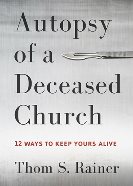Reviewed by Fred G. Zaspel
If there is anything sadder to see than a deceased church it is a deceased church who in its lifetime had known the abundant blessing of God in unusual gospel effectiveness. More sad still is the fact that the sight is not uncommon.
There are few, if any, who are better informed on all things church than Thom Rainer, president and CEO of LifeWay Christian Resources. The data he has accumulated over the years has often been put into print for the profit of many, and this time he turns his attention to deceased churches. He has written not so much to tell us about dead churches and what they did wrong but rather, as the subtitle tells us, to learn from them how to keep our churches alive. What can we learn from those churches who failed?
Overview
Rainer highlights those factors that contribute to church decline. Here’s the Table of Contents:
Part 1: The Autopsy
1. Introduction
2. Slow Erosion
3. The Past is the Hero
4. The Church Refused to Look Like the Community
5. The Budget Moved Inwardly
6. The Great Commission Becomes the Great Omission
7. The Preference-Driven Church
8. Pastoral Tenure Decreases
9. The Church Rarely Prayed Together
10. The Church Had No Clear Purpose
11. The Church Obsessed over the Facilities
Part 2: Is There Hope for a Dying Church? Twelve Responses
12. My Church Has Symptoms of Sickness
Four Responses
13. My Church Is Very Sick
Four Responses
14. My Church Is Dying
Four Responses
Some Warning Signs
Most of Rainer’s autopsy findings are not surprising. We are not surprised, for example, to read,
The most pervasive and common thread of our autopsies was that the deceased churches lived for a long time with the past as hero. They held on more tightly with each progressive year. They often clung to things of the past with desperation and fear. And when any internal or external force tried to change the past, they responded with anger and resolution: “We will die before we change.”
And they did.
The struggle was not over biblical teachings, questions of morality, and such, but over the past. They glory in what they were and hope against hope they can get back there, and so they just won’t change. It’s what I call the last seven words of a dying church – “We’ve never done it that way before!”
Other factors, of course, play in also. It would be difficult to imagine a church dying that keeps the great commission on the front burner. And we forget that the work requires the supernatural – and so we forget to pray together. And when we do pray, it is not so much for concerns over advancing the kingdom as it is concerns for Aunt Susie’s hospital stay. There may be any of a thousand factors that could conspire to bring a church’s witness to an end, but somehow these thousand factors seem to have less bearing on a church that remains intentionally focused on its reason for being and on the means God has given for it to advance … in any circumstances.
The sad thing is, as Rainer points out, that church death usually follows a slow and often unnoticed process of erosion and decline. Losing sight of priorities and biblical prescriptions for health and advance we coast along, not outward- but inward-focused, often until it is too late. “As many as 100,000 churches in America are showing signs of decline toward death,” Rainer writes. Staggering.
Some Prescriptions for Health
In chapter 12, “My Church Has Symptoms of Sickness,” Rainer prescribes these four responses:
1. Pray that God will open the eyes of the leadership and members for opportunities to reach into the community where the church is located.
2. Take an honest audit of how church members spend their time being involved (i.e., are they inward-focused, or do they look to ministry beyond the doors of the church?).
3. Take an audit of how the church spends its money.
4. Make specific plans to minister and to evangelizes your community.
In chapter 13, “My Church is Very Sick,” Rainer prescribes four responses also:
1. The church must admit and confess its dire need.
2. The church must pray for wisdom and strength to do whatever is necessary.
3. The church must be willing to change radically.
4. That change must lead to action and an outward focus.
Autopsy of a Deceased Church is a small-sized book and an easy, quick read. But it is packed with the kind of reminders every church needs, and with it Thom Rainer has rendered us yet another great service. Tolle lege!
Fred G. Zaspel
Buy the books

Autopsy Of A Deceased Church: 12 Ways To Keep Your Church Alive